 Exhibitions Archive
Exhibitions Archive
 Exhibitions Archive
Exhibitions Archive

AZ14. Old Testament Trinity, Hospitality of Abraham, Troitsa
Russian, Pskov School, 16th century.
Panel: 30 x 24cm; thickness 2.4cm![hideselects= [On] header =[Convert size] body = [Click here to show the size in inches] Click here to convert metric size to imperial](images/inches.gif) (the dimensions indicate that it was made for private devotion).
(the dimensions indicate that it was made for private devotion).
Condition: Conserved by Martin Bould See Fig. 4.
Inscription: Fragmentary inscription in old Slavonic in red on the upper border: Staraya, the first word of Staraya Troitsa Old Testament Trinity.
Provenance: private collection England; Temple Gallery, 1980s.

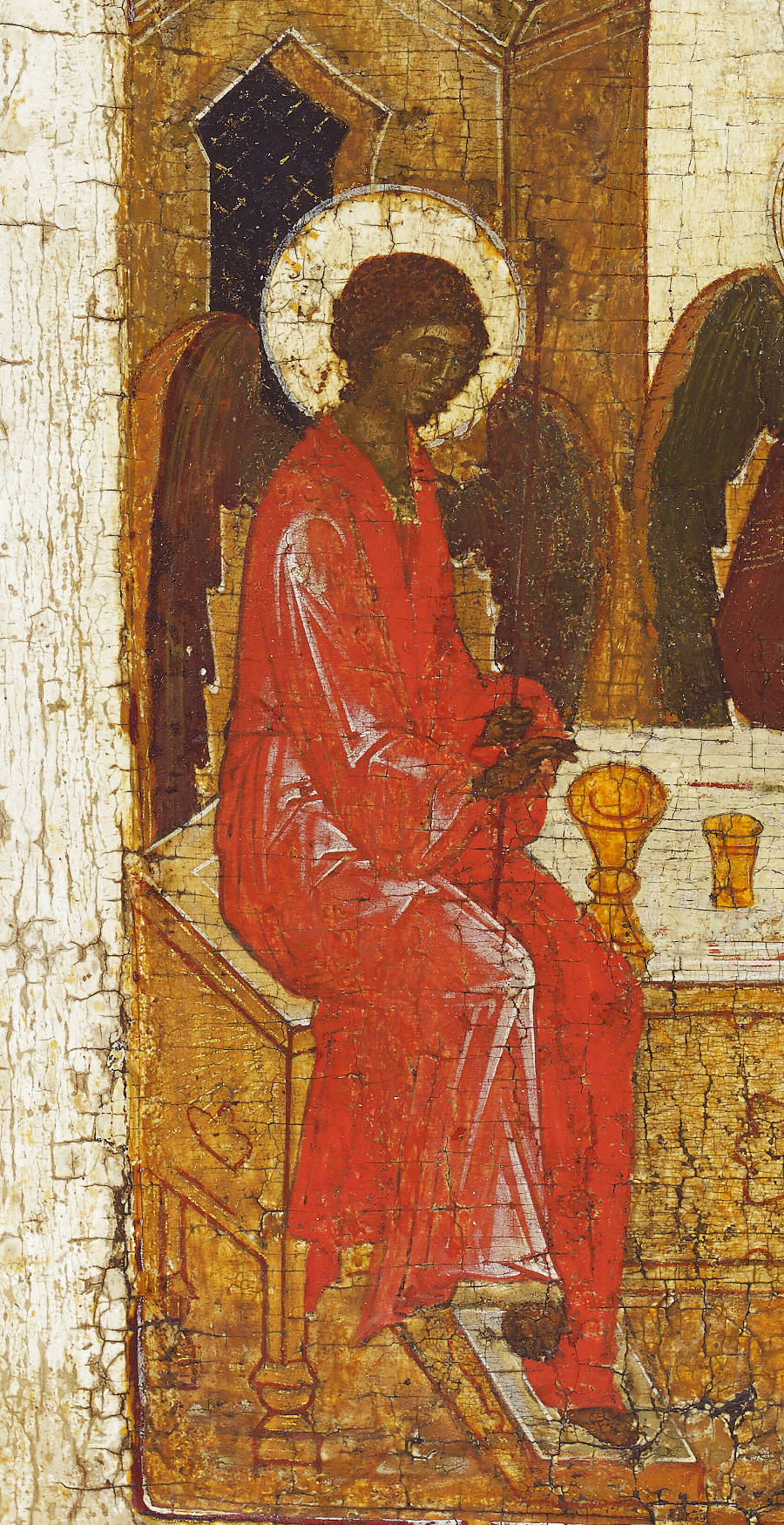
No. 14, detail.
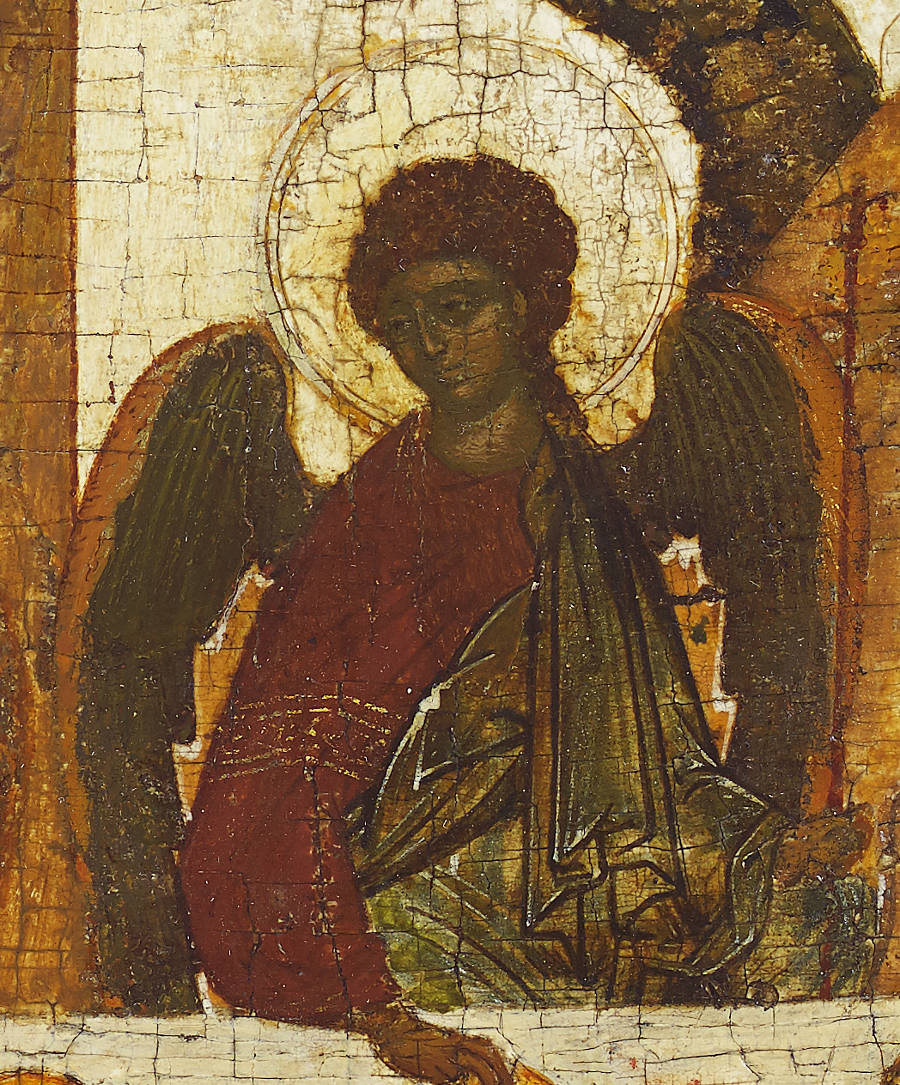
No. 14, detail.
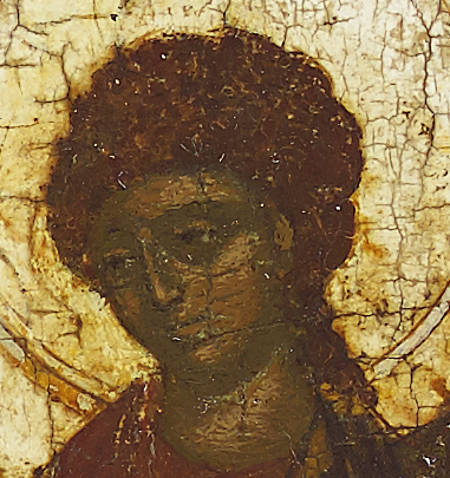
No. 14, detail.
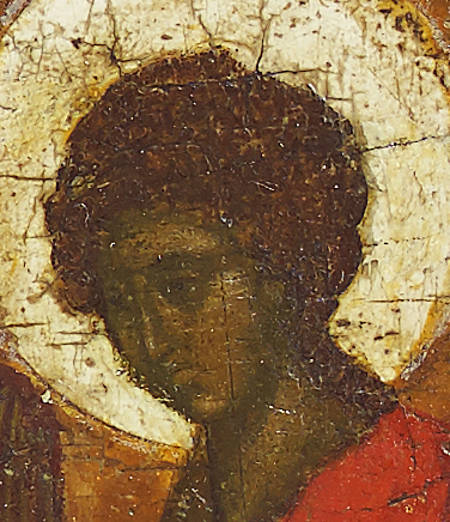
No. 14, detail.
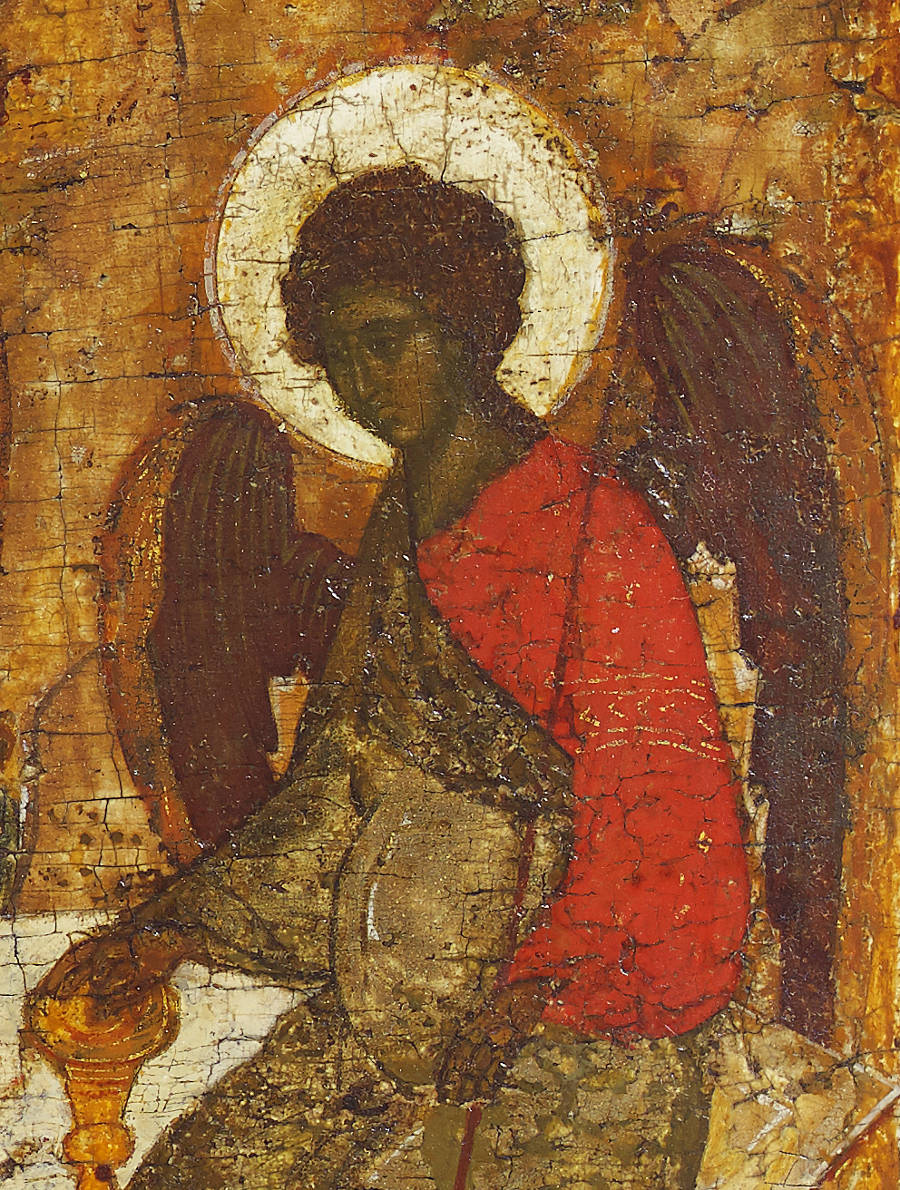
No. 14, detail.
The icon is based on the composition of Andrei Rublev’s famous image of the Trinity painted in 1408 (Fig. 1). Originally for the church at Sergeiev Posad (formerly Zagorsk) housing the relics of St Sergius, Rublev’s icon now hangs in the Tretyakov Gallery in Moscow.
Icons of the Trinity depict the event recounted in Genesis 18 where ‘three young men’ appear before Abraham and his wife Sarah and foretell, despite their advanced age, the birth of their son. Early Christian theologians interpreted Abraham’s use of the singular -- he addresses the three visitors as ‘My Lord’ -- as an epiphany or divine manifestation of God; in this case in his triune form.
Older versions depicted the narrative elements of the story and included the figures of Abraham and Sarah and the sacrificial calf. Rublev’s composition dispensed with these and reduced the design to its most basic elements thereby giving priority to its mystical and symbolic meaning. His icon from then on was the prototype on which painters modelled their work. The present example, No. 14, follows Rublev fairly closely. We see the three angels around a table or altar with vessels and a chalice and toward which they gesture. Above the central angel is the ‘Oak of Mamre’ of the Genesis text. We see the stools of the two angels in the foreground and their footstools drawn in classic Byzantine reverse perspective. Behind the angel on our left is Abraham’s ‘tent’, a tall cubistic structure with a door and a double-arched window and on the top a narrow pyramid. Here the painter uses aerial perspective – we are looking down on the roof – and elsewhere a kind of linear perspective. For example, we look up into the doorway and the arched window above. However, the viewing angle changes: the doorway is seen from the left, letting us glimpse the right-hand inside width of the wall, while the arches above are viewed from the right so that we see the left hand inside width. A rocky mountain is placed somewhat incongruously behind the table but in front of the tree.
The figures of the Trinity’s gestures seem to invite the viewer to come closer. The spectator becomes an integral part of the scene, collapsing the space between the viewer and the viewed. We pass into the Holy space within the icon and share our space with the divine figures represented within. Thus, we gain the ability to commune with them and through them, connecting us to God.1
Such features are typical for Russian art in the fifteenth and sixteenth centuries. They were absorbed from Palaiologan, and by implication Hesychast, ideas developed in the monasteries of Constantinople and Mount Athos. We remember that after the fall of the city in 1453 Russia became the guardian of the innermost traditions of Orthodoxy. Constantinople had been the ‘Second Rome’ and after its fall Moscow lost little time declaring itself the ‘Third Rome’. Historians today see this as geo-politics but its deeper significance was to guarantee the continuity of mystical theology and the knowledge of Divine Wisdom.
Thus, in an icon such as our Trinity the apparent illogicalities and incongruities are an intentionally developed visual language that raises the viewer’s mind from a literal viewpoint and invites us to take in the symbolic aspect of the mysterious event. The genius of the medieval icon was to bring us readily in front of truths enacted not in time or in space but in the non-material world. The language of the psyche is not logical but psychological. Here art, with its freedom to use abstract forms, is never ‘naturalistic’ but surpasses nature.
The medieval religious mind, accessible through the writings in the West of Meister Eckhart, Thomas à Kempis or the anonymous author of The Cloud of Unknowing and in the East through Dionysius the Areopagite, John Cassian or Gregory Palamas2, would of course have no difficulty with such imagery. It was universal, familiar and everywhere recognisable. Sacred art was ‘abstract’, founded on the mathematics of Pythagoras and Euclid; God created the universe by geometry3.
Christianisation came to the Slavs in the tenth century with the conversion of Prince Vladimir of Kiev, the process being completed in Russia between the twelfth and fifteenth centuries. The same period saw the sacred arts in Europe (Romanesque and Gothic architecture) and in Byzantium (icons, mosaics and wall-paintings) reach their supreme achievement. Likewise, the Russian icon attained its ‘golden age’ between the middle of the fourteenth century to the middle of the sixteenth. Certainly, painters from Novgorod, Pskov, Suzdal and later Moscow drew on the art of Byzantium but they were to make their own unique contribution: while never contradicting the canonicity or the orthodoxy of the tradition, they found a freedom from dogmatism in which to express their visions of truth. This freedom would open the doors to lyrical and poetic qualities not found in the Greek world and which seem to be uniquely Slavic. The result is pure art and pure theology.
An important historical event in late medieval Russia was the Church Council in Moscow summoned by Ivan IV (‘the Terrible’) and Metropolitan Markary to settle questions of ritual and practice. It was held in 1551 and called the Stoglav or Council of a Hundred Chapters. Among the rulings laid down for icon painters was the injunction to ‘follow the models of Andrei Rublev and the older Greek masters’. Our painter’s drawing and positioning of the three Persons with the central figure (probably Christ) and right-hand figure (probably God the Father) looking towards the pink-clad angel who is probably the Holy Spirit, follow the prototype closely though the background elements, architecture, tree and mountain, are stated more emphatically than in the Rublev version. And our painter certainly conveys the profound sense of stillness and peace, the ‘love of concord’, between the three Persons through the interplay of their movements and gestures. It should be said here that Father Silouan, the Hesychast priest/monk who advises the Temple Gallery on theological matters, takes another view. He suggests that the central figure, Christ the Incarnate Son, together with the Holy Spirit, the figure on the right, both look toward the Father at the left.
If we have identified the Persons correctly then the symbolism of the background corresponds. The mountain signifies the cosmic exaltation of the Father, the tree is life or nature and thus the incarnation, ‘God with us’, and the house is the enclosure of space indicating the inner life: ‘the house of spiritual architecture’4 accessed through contemplative prayer.5 Father Silouan’s interpretation, which we cite above, invites us to consider the mountain as symbolically related to the Spirit and the architecture to the Father. The mystery of the Trinity is beyond conceptual thought but the icon is a good example of how far art can explore that ‘other’ world where the earth-bound mind cannot go. The true function of the icon, employing methods such as multiple perspective points, inherited from Byzantium, is to explore the higher realities existing beyond the laws of time and space. The artist’s thought is freed from the three-dimensional world which is why the images he depicts stand outside physical laws; they are ‘dematerialised’ so that what appears as illogical and incongruous to the logical mind reveals its meaning to the psychological mind.6
The idea of the Holy Trinity is too vast to summarise here. It has ramifications in theology, in philosophy, in iconography and in esoteric tradition. I would refer readers to a short commentary by Nicholas Zernov7 or, for an extended study, the writing of Gabriel Bunge.8
Fig. 1. Rublev Trinity, 1411. Tretyakov Gallery, Moscow
There was little development after the establishment of Rublev’s prototype throughout the remainder of the fifteenth century and during most of the sixteenth. We can, however, observe variations of emphasis and shifts of nuance in certain details according to the spiritual understanding either of the painter himself or of the atelier or ‘school’ where he worked. In a small icon, once in the Temple Gallery and now in Novgorod, dating from around 1500 (Fig. 2) the painter gives more attention to the three background elements, as has the painter of our icon. But this is not sufficient reason to assign our icon to the Novgorod School. Other elements such as the use of colour can be considered. If Muscovite painting is characterised by ‘colour transparency’ and Novgorod by ‘colour saturation’ our icon combines both techniques - something which is not uncommon in the sixteenth century. The Grand Duchy of Moscow had assimilated the Republic of Novgorod in 1478 after victory in battle after which artists from both centres freely exchange artistic styles and techniques.
Fig. 2. Trinity, Novgorod School; c. 1500. Museum of History and Art, Novgorod
Another possibility, and the one I think more likely, is that our icon was painted in Pskov. Pskov became part of Moscow in 1510 with similar artistic cross fertilisation; but one noticeable feature of Pskovian art is the employment of a characteristic range of dense and often somewhat dark colours derived from local pigments. Thus, we often see rich dark brown under-painting of the faces such as we observe in the similarity between the right-hand angel in No. 14 and the head of the Virgin in a well-known icon of Saint Luke painting the Virgin in the Pskov Museum9 (Fig. 3).
Fig. 3. Detail of a mid-16th c. icon in the Pskov Museum. |
No. 14. detail |
Another comparison can be made with a mid-sixteenth century icon of the Trinity, also in the Pskov Museum (Fig. 4). It is the upper part of a monumental double icon (the lower part is a standing figure of St John Chrysostom) and so is not conceived on the intimate scale of our example. It is one of twenty-four icons on twelve panels constituting two upper rows of an iconostasis, in other words an entire wall. The festival scenes were thus designed to be seen from quite far away and painted for dramatic effect rather than intimacy and elegance. The form of the tree and the rocky mountainous outcrop with its double peak are nonetheless strikingly similar (Fig. 4. detail, No. 14. detail.)
Fig. 4. Trinity. Pskov School, mid-16th c. Pskov Museum.
Fig. 4, detail |
No. 14. detail |
Fig. 5 Christ the Unsleeping Eye, mid-16th Century, Pskov School |
No. 14 |
Our icon has affinities with another work in the Pskov Museum, the ‘Saviour of the Unsleeping Eye’10. Both icons are of similar size, i.e. small-scale devotional objects, and have a similar combination of vermilion pink and sombre colours, especially the faces, all seen against a white ground. Both icons are in similar state of preservation. The proportion of the figures in the space is similar. Rodnikova states that the ‘characteristic palette built on rich colours … and the ability to convey intricate theological ideas distinctly and accessibly, constitute the indigenous Pskov style’.11
Fig. 6, a later example from the end of the sixteenth century or the beginning of the seventeenth, shows how the composition becomes academic and conventional. The disposition of the three background elements and the three angels is flat and lacks the dynamic rhythm that unifies the composition in the earlier examples (Fig. 4).
Fig. 6. Trinity, circa 1600. Russian Works of Art, Fabergé & Icons, Sotheby’s, 2017. Lot 439
Fig. 7. Conservator’s diagram showing retouched scorch marks caused by being too close to an oil lamp (lampada). There are old, perhaps 18th- or 19th-century repairs to the gesso on the upper border.
Fig. 8. Back of panel
Footnotes:-